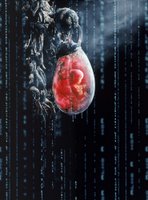This lesson was copied from
How Stuff Works in an effort to enlighten those that think Carbon-14 dating is some mystical, innaccurate or unreliable (yes I'm talking to you Creationists) process for fiding the age of really old things.
First, where does Carbon-14 come from?

Cosmic rays enter the earth's atmosphere in large numbers every day. For example, every person is hit by about half a million cosmic rays every hour. It is not uncommon for a cosmic ray to collide with an atom in the atmosphere, creating a secondary cosmic ray in the form of an energetic neutron, and for these energetic neutrons to collide with nitrogen atoms. When the neutron collides, a nitrogen-14 (seven protons, seven neutrons) atom turns into a carbon-14 atom (six protons, eight neutrons) and a hydrogen atom (one proton, zero neutrons). Carbon-14 is radioactive, with a
half-life of about 5,700 years.
The carbon-14 atoms that cosmic rays create combine with oxygen to form carbon dioxide, which plants absorb naturally and incorporate into plant fibers by photosynthesis. Animals and people eat plants and take in carbon-14 as well. The ratio of normal carbon (carbon-12) to carbon-14 in the air and in all living things at any given time is nearly constant. Maybe one in a trillion carbon atoms are carbon-14. The carbon-14 atoms are always decaying, but they are being replaced by new carbon-14 atoms at a constant rate. At this moment, your body has a certain percentage of carbon-14 atoms in it, and all living plants and animals have the same percentage.
As soon as a living organism dies, it stops taking in new carbon. The ratio of carbon-12 to carbon-14 at the moment of death is the same as every other living thing, but the carbon-14 decays and is not replaced. The carbon-14 decays with its half-life of 5,700 years, while the amount of carbon-12 remains constant in the sample. By looking at the ratio of carbon-12 to carbon-14 in the sample and comparing it to the ratio in a living organism, it is possible to determine the age of a formerly living thing fairly precisely.
A formula to calculate how old a sample is by carbon-14 dating is:
t = [ ln (Nf/No) / (-0.693) ] x t1/2
where ln is the natural logarithm,
Nf/No is the percent of carbon-14 in the sample compared to the amount in living
tissue, and t1/2 is the half-life of carbon-14 (5,700 years).
So, if you had a fossil that had 10 percent carbon-14 compared to a living sample, then that fossil would be:
t = [ ln (0.10) / (-0.693) ] x 5,700 years
t = [ (-2.303) / (-0.693) ] x 5,700 years
t = [ 3.323 ] x 5,700 years
t = 18,940 years old
Because the half-life of carbon-14 is 5,700 years, it is only reliable for dating objects up to about 60,000 years old (other techniques can increase this accuracy to 100,000 years). However, the principle of carbon-14 dating applies to other isotopes as well. Potassium-40 is another radioactive element naturally found in your body and has a half-life of 1.3 billion years. Other useful radioisotopes for radioactive dating include Uranium -235 (half-life = 704 million years), Uranium -238 (half-life = 4.5 billion years), Thorium-232 (half-life = 14 billion years) and Rubidium-87 (half-life = 49 billion years).
The use of various radioisotopes allows the dating of biological and geological samples with a high degree of accuracy. However, radioisotope dating may not work so well in the future. Anything that dies after the 1940s, when nuclear reactors and open-air nuclear tests started changing things, will be harder to date precisely.
The Limitations of Carbon 14 Dating First, the size of the archaeological sample is important. Larger samples are better, because purification and distillation remove some matter. Although new techniques for working with very small samples have been developed, like accelerator dating, these are very expensive and still somewhat experimental.
Second, great care must be taken in collecting and packing samples to avoid contamination by more recent carbon. For each sample, clean trowels should be used, to avoid cross contamination between samples. The samples should be packaged in chemically neutral materials to avoid picking up new C-14 from the packaging. The packaging should also be airtight to avoid contact with atmospheric C-14. Also, the stratigraphy should be carefully examined to determine that a carbon sample location was not contaminated by carbon from a later or an earlier period.
Third, because the decay rate is logarithmic, radiocarbon dating has significant upper and lower limits. It is not very accurate for fairly recent deposits. In recent deposits so little decay has occurred that the error factor (the standard deviation) may be larger than the date obtained. The practical upper limit is about 50,000 years, because so little C-14 remains after almost 9 half-lives that it may be hard to detect and obtain an accurate reading, regardless of the size of the sample.
Fourth, the ratio of C-14 to C-12 in the atmosphere is not constant. Although it was originally thought that there has always been about the same ratio, radiocarbon samples taken and cross dated using other techniques like dendrochronology have shown that the ratio of C-14 to C-12 has varied significantly during the history of the Earth. This variation is due to changes in the intensity of the cosmic radiation bombardment of the Earth, and changes in the effectiveness of the Van Allen belts and the upper atmosphere to deflect that bombardment. For example, because of the recent depletion of the ozone layer in the stratosphere, we can expect there to be more C-14 in the atmosphere today than there was 20-30 years ago. To compensate for this variation, dates obtained from radiocarbon laboratories are now corrected using standard calibration tables developed in the past 15-20 years. When reading archaeological reports, be sure to check if the carbon-14 dates reported have been calibrated or not.
Finally, although radiocarbon dating is the most common and widely used chronometric technique in archaeology today, it is not infallible. In general, single dates should not be trusted. Whenever possible multiple samples should be collected and dated from associated strata. The trend of the samples will provide a ball park estimate of the actual date of deposition. The trade-off between radiocarbon dating and other techniques, like dendrochronology, is that we exchange precision for a wider geographical and temporal range. That is the true benefit of radiocarbon dating, that it can be employed anywhere in the world, and does have a 50,000 year range.
Labels: carbon dating, creationism, evolution













